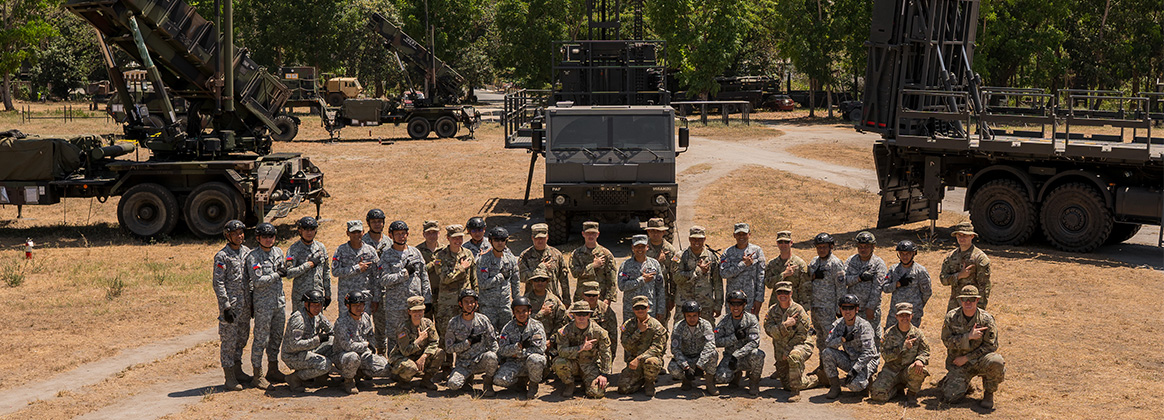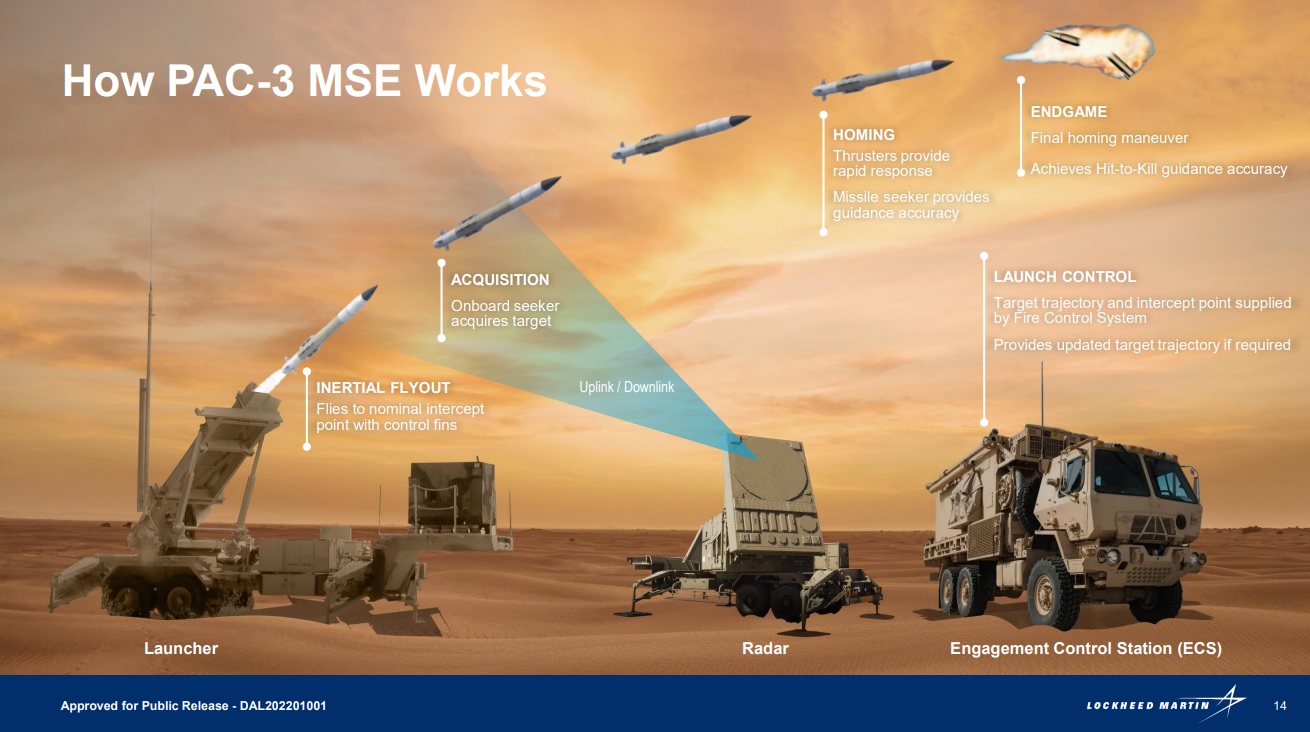From the Eurasia Times (May 3, 2024): Patriot Missiles ‘Roar’ Near China; Cutting-Edge SAMs Deployed To Clark AFB, Once Home To US Military (By Sakshi Tiwari)
Amid frequent ‘attacks’ on Filipino vessels by China, the U.S. Army has deployed its cutting-edge Patriot missile defense system to the Philippines Clark Air Force Base (AFB), which once boasted a massive U.S. presence.According to reports, the U.S. Army has stationed Patriot missile launchers — for the first time — at the Clark AFB. The facility is located north of the capital city of Manila and is used for military and civilian aircraft operations.
U.S. Army soldiers attached to 1-1 Air Defense, 38th Air Defense Brigade, deployed the Patriot Antenna Mast Group for the MIM-104 Patriot surface-to-air missile system at the AFB late last month for the ongoing Balikatan exercises.
The U.S. Indo-Pacific Command published photographs of its forces posing along with the 960th Air and Missile Defense Group, the Philippine Air Force, in what was described as the “first-ever gathering of a U.S. Patriot and Filipino Surface-to-Air Python and Derby air defense system during Exercise Balikatan 24 at Clark Air Base, Philippines,” this week.
Additionally, reports noted that two launchers from Bravo Battery, 1st Battalion, 1st Air Defense Artillery Regiment, headquartered in Okinawa, pointed skyward from a field in Clark’s Air Force City, home to Filipino soldiers who share a nearby runway with commercial jets that visit Clark International Airport.

File: U.S. Army soldiers pose with their Filipino counterparts at the first-ever gathering of a U.S. Patriot and Filipino Surface-to-Air Python and Derby air defense system during ongoing Balikatan exercises.
Some 50 soldiers from Bravo Battery have been training for a scenario where they are required to protect Clark AFB, one of the most strategically located military bases in the Philippines, from an incoming missile attack.
It is no surprise that troops are going through the same exercises they have practiced across the Indo-Pacific in the face of China’s growing threats.
The deployment to Clark is significant as it comes against the backdrop of recurrent Chinese assaults on Filipino vessels. On May 1, for instance, China’s coast guard fired water cannons that damaged a Philippine vessel. The Philippines said the vessel was conducting “legitimate patrols” near the Scarborough Shoal when it came under attack.
This was the latest incident of the recurrent maritime run-ins between the two sides that has gone on for several months now, with Chinese Coast Guard vessels relentlessly attacking Filipino ships in contested areas like Scarborough and the Second Thomas Shoal. China claims almost the entire South China Sea as its sovereign territory.
Pushed to the wall by a much more powerful adversary, the Philippines has secured assurance and support from the U.S. The Biden administration recently reiterated his country’s iron-clad commitment to the Philippines and warned that an attack on Manila could trigger the Mutual Defense Agreement (MDA).
However, expanding its cooperation with allies in the Indo-Pacific has also been seen as a U.S. strategy for countering China in the region. The ongoing Balikatan drills, the largest to be held to date, have been interpreted as “force projection” and establishing deterrence against China.
As for the Clark AFB, it has a history of being the largest U.S. base in the region before things changed and the control was transferred. Moreover, the U.S. has strengthened cooperation with the Philippines and secured access to additional military bases.
Some 50 soldiers from Bravo Battery have been training for a scenario where they are required to protect Clark AFB, one of the most strategically located military bases in the Philippines, from an incoming missile attack.
It is no surprise that troops are going through the same exercises they have practiced across the Indo-Pacific in the face of China’s growing threats.
The deployment to Clark is significant as it comes against the backdrop of recurrent Chinese assaults on Filipino vessels. On May 1, for instance, China’s coast guard fired water cannons that damaged a Philippine vessel. The Philippines said the vessel was conducting “legitimate patrols” near the Scarborough Shoal when it came under attack.
This was the latest incident of the recurrent maritime run-ins between the two sides that has gone on for several months now, with Chinese Coast Guard vessels relentlessly attacking Filipino ships in contested areas like Scarborough and the Second Thomas Shoal. China claims almost the entire South China Sea as its sovereign territory.
Pushed to the wall by a much more powerful adversary, the Philippines has secured assurance and support from the U.S. The Biden administration recently reiterated his country’s iron-clad commitment to the Philippines and warned that an attack on Manila could trigger the Mutual Defense Agreement (MDA).
However, expanding its cooperation with allies in the Indo-Pacific has also been seen as a U.S. strategy for countering China in the region. The ongoing Balikatan drills, the largest to be held to date, have been interpreted as “force projection” and establishing deterrence against China.
As for the Clark AFB, it has a history of being the largest U.S. base in the region before things changed and the control was transferred. Moreover, the U.S. has strengthened cooperation with the Philippines and secured access to additional military bases.
Clark’s AFB Was Once A US Base
Clark Air Base is a Philippine Air Force base on Luzon Island in the Philippines, about 30-40 miles away from Manila. Before 1991, Clark Air Base was a military installation owned and run by the United States Air Force. It was part of the Pacific Air Forces (PACAF) and its predecessor organizations.
The installation occupied 14.3 square miles, and an additional 230 square miles of military reserve stretched north of the base. During the last few months of World War II, the facility served as a bastion for the combined forces of the Philippines and the United States. It also provided key logistical support during the Vietnam War of 1975.
However, when Mount Pinatubo erupted in 1991, and the Philippine Senate rejected an extension of American military bases there, the US forces were told to leave the country. The base later housed Clark International Airport, the Clark Freeport Zone, and the Philippine Air Force’s Air Force City.
Clark Air Base – Wikipedia
U.S. forces returned to the Philippines in 1999 to participate in a large-scale exercise under a Visiting Forces Agreement (VFA). In 2016, a contingent of the U.S. Air Force was located at Clark AFB for patrolling the contentious South China Sea.
The U.S. does not have access to this base, unlike the nine bases opened for the U.S. under the Enhanced Defense Cooperation Agreement (EDCA). The base, however, continues to host visiting U.S. troops regularly. For instance, USAF F-22 Raptors were photographed training there last year.
China has been keenly watching the developments at Luzon. In June 2022, the Australian P-8A reconnaissance aircraft intercepted by Chinese J-16 fighters in a dangerous maneuver had reportedly taken off from Clark AFB.
As tension between the Philippines and China continues to grow, there are concerns that it could spiral into a full-blown conflict, necessitating the ramping of the country’s defenses. This explains the U.S. troops training to protect Clark AFB.
U.S. forces returned to the Philippines in 1999 to participate in a large-scale exercise under a Visiting Forces Agreement (VFA). In 2016, a contingent of the U.S. Air Force was located at Clark AFB for patrolling the contentious South China Sea.
The U.S. does not have access to this base, unlike the nine bases opened for the U.S. under the Enhanced Defense Cooperation Agreement (EDCA). The base, however, continues to host visiting U.S. troops regularly. For instance, USAF F-22 Raptors were photographed training there last year.
China has been keenly watching the developments at Luzon. In June 2022, the Australian P-8A reconnaissance aircraft intercepted by Chinese J-16 fighters in a dangerous maneuver had reportedly taken off from Clark AFB.
As tension between the Philippines and China continues to grow, there are concerns that it could spiral into a full-blown conflict, necessitating the ramping of the country’s defenses. This explains the U.S. troops training to protect Clark AFB.

Via: Lockheed Martin
The Patriot training is difficult because of the neighboring civilian population. In recent years, much of Clark has been transformed from military installations to commercial and recreational areas. The troops have, nevertheless, carried out numerous drills in the last week.
The soldiers have been practicing as if they are defending Clark, even though they have not been firing actual missiles during the exercise.
Besides training the troops to protect the Clark base in the event of hostilities, the transfer of Okinawa’s Patriot to Clark may have additional significance. U.S. experts have noted that U.S. military bases in the region, especially Okinawa, would come under attack from China if a conflict broke out between the two sides.
So, the commanders have been looking at other bases which could be co-opted and used in case of hostilities.
The Patriot training is difficult because of the neighboring civilian population. In recent years, much of Clark has been transformed from military installations to commercial and recreational areas. The troops have, nevertheless, carried out numerous drills in the last week.
The soldiers have been practicing as if they are defending Clark, even though they have not been firing actual missiles during the exercise.
Besides training the troops to protect the Clark base in the event of hostilities, the transfer of Okinawa’s Patriot to Clark may have additional significance. U.S. experts have noted that U.S. military bases in the region, especially Okinawa, would come under attack from China if a conflict broke out between the two sides.
So, the commanders have been looking at other bases which could be co-opted and used in case of hostilities.
https://www.eurasiantimes.com/patriot-missile-defense-system-to-the-philippines-clark/#google_vignette

No comments:
Post a Comment
Note: Only a member of this blog may post a comment.